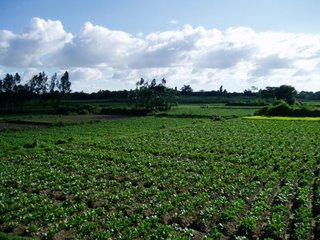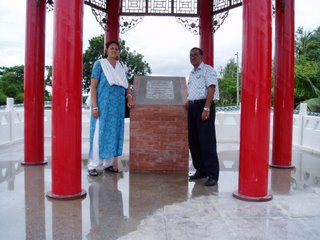A Special Adventure
 a typical home in the village of vajrayogini
a typical home in the village of vajrayogini
 the pagoda and inaguration plaque built by the chinese embassy of bangaldesh
the pagoda and inaguration plaque built by the chinese embassy of bangaldesh
Friday, July 28, 2006 I had a small list of things I wanted to do here in Bangladesh, missions to be completed. At the top of the list was a visit to my Guruji's village Vajrayogini. This is also the village of the birthplace of the great Buddhist Scholar and Master, Atisa Dipankara Srijnan. Atisa Zobo, as he is known to the Tibetans, is the founder of the Kadampa Sect, student of Naropa and teacher of Domtonpa. It was Atisa that took the last updated Vajrayana teachings to Tibet before Buddhism was wiped out in India for good. What survived were the lineages in Tibet, Bhutan and Sikkim. Atisa was also a head teacher at the great Vikramshila, Somapura Vihara and many others. I found Vajrayogini on a map just before I left the states, and put it out there to the universe at large to make it happen if it will. When I arrived in the airport in Dhaka, I got through immigration very quicky, and then went over to get my luggage. There was my suitcase just sitting right there, it must have come on an earlier flight. I have lots of time to wait for the group to finish getting through immigration and getting luggage. In the mean time, I was chatting with one of fellows who came to pick us up from the airport, Mr. Tipu from the AIBS (American Institute of Bangladesh Studies) which is one of our sponsors. We started chatting and I came out fast that I wanted to go to the village called Vajrayogini among some other intrests. Lo and Behold! Mr. Tipu was from Vajrayogini! I met him one time at the AIBS office last week and hounded him for research in Lalon Geeti, Buddhist Sahajiyas, Doha traditons, and Sufi mystics. No time to waste! He organized a car for us to head out today and drive about two hours South to our destination. We had as our guide a jounalist from the region, called Vikrampur. We left early, although it is a weekend day and there is not a lot of traffic. The morning was beautiful with sunny skies, perfect temperature, and a lot of breeze. We headed out the south of the city, and then through an industrial supply region called Narayanjanj. We loaded a big ferry with buses, cars rickshaws and people, to cross a river, and then another half-hour to Vajryogini village. The village was very green (as to be expected in the rainy season), the ponds were clean and full, and it was jute harvesting time. They cut the jute from the soil, then soak it in the pond. Then they dry it and pull off the fibers. From there it goes pulp to rope or fabric. People have been doing this for a long long time here. Jute is still one of main exports of Bangladesh. Down an unsuspecting single-car sized brick road, about two hundread feet down and on the left side is a stone marker of where Atisa was born. He was born to the king and queen of the land, himself a Dharma King (Chogyal). And today, that's all there is. Apparetly, the Chinese Embassy in Dhaka donated a bunch of money to construct a pagoda and new plaque at the site. The minister who hosted this construction's name was just as big as the Master Atisa. Who is more important? Three feet away is a Muslim family who invited us into their home for tea. From them we got a different story of how that was his farm land, and the government took it from him, and didn't ask or offer him anything for it. He wasn't upset about it, but thought it wasn't right. Across the road they were constructing a museum for the site. But what will they put in it? This Muslim man had been there his whole life, and told that in the Liberation War the Pakistan arrmy destroyed all buildings there. That included Atisa's family's home, family temple, and library. There are no Buddhists living in this region now, and nothing really to put in this museum. There is no excavation or archeological investigation going on, yet all the village people find relics and old stupa every time they dig in the soil. As much as I am for the presevation of historic sites, and Buddhist lineages, I think that there could be better use of the money and space. Build an interfaith teaching center where all the faiths of Bangladesh will be taught to everyone. Not just because this used to be Buddhist so it should be restored to that. Who will go there? Just foreigners? I know it was not my imagination, but there was a strong energy resonance at the stone marker site. When we were walking close to it, by heart started racing and I felt a strong pulsing in my heart center. I could feel a distinct magnetic field, and truly felt honored to be there, even if it was nowhere. We drove back on a windy road through other beautiful small villages. Passing so many waterways with indigenous fishing nets resting above the water, and jute hanging on the numerous small bridges we crossed on the two hour drive back to Dhaka. We stopped for the all-important Raush Golah sweets and sweet youghurt (Mishti Dohi). Best had in the village. By two pm I was back to my house, really charged up from a mission and pilgrimage accomplised. I recently bought a book published from a 2004 conference on Atisa, that also told about the great Masters Tilopa and Naropa who were from Chittagong. We have plans to head there on the 3rd of August, so lets see what treasure hunting awaits there ................ Four Winds, Yoli aka Kurukulla PS: It all happens if you just let it unfold......... |

1 Comments:
This was very interesting to read! My father's family is originally from this village, but they moved to Calcutta before the partition of India. From the stories he tells me it used to be a well-preserved and beautiful village with temples, schools, libraries and many inhabitants before they moved..and it's sad to read that nothing is left.
Post a Comment
<< Home